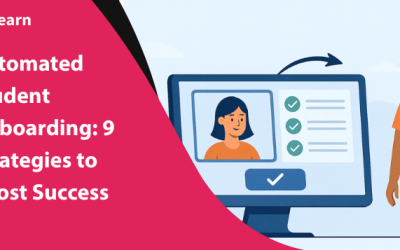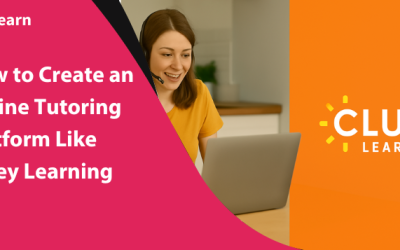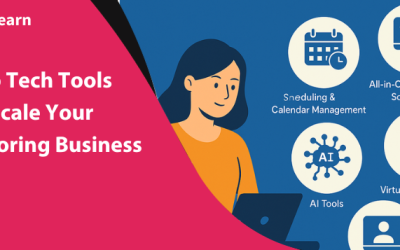AI Tutors & Co-Teaching: The New Standard in Online Education
As the transformative power of AI is reshaping industries across the globe, AI is no exception. AI influences e-learning in myriad ways: personalized learning, instant feedback & learner analytics and engagement.
Every educator wants to know how to leverage AI and go beyond rote memorization to deliver a more dynamic learning experience.
In this blog, we discuss the benefits of AI in education, different ways to integrate AI tutors and co-teaching tools, and a few watchouts throughout the process.
TL;DR
- AI tutors and teaching assistants are transforming online education by building more personalized, scalable and adaptive learning systems.
- Personalized lesson planning, instant feedback, enhanced engagement, collaborative learning, learning analytics, are the different ways AI tutors & assistants are transforming the educational landscape.
- AI platforms and generative tools automate repetitive administrative tasks like writing, grading, attendance tracking. This saves their time and efforts and helps to focus on improving teaching style and more creative tasks.
- Challenges of AI implementation in online education: Transparency & bias, security concerns, teacher’s resistance, over-reliance, and cheating.
What are AI Tutors?
An AI Tutor uses artificial intelligence to offer personalized learning, adapting to the learner’s style, pace and preferences. While traditional learning is based on a one-size-fits-all approach, AI fine-tunes the learning experience and makes it accessible and adaptive.
Key Functionalities:
Here are the key areas where AI tutors support traditional learning:
- Personalized lesson plan based on the learner’s skill, preferences, and interests
- Instant feedback on assignments or problems
- Predictive analytics based on the learner’s past behaviour and performance
- Chat support offering 24/7 instant help and support
- Step-by-step solution for complex problems
What are the Key Benefits of AI Tutors & Co-Teaching?
According to a recent Google DeepMind study, human tutors taking AI assistance while teaching were just as effective as an expert human tutor.
This explains the impact of AI tutors and co-teaching in the modern learning scenario. Imagine each and every student on the planet being able to access expert tutoring. With collaborative AI-human tutoring, that’s possible!
Here are the reasons why AI-human tutoring collaboration is a game-changer:
Enhance Ongoing Learning & Development
Human tutors can involve AI in classroom learning by curating adaptive lessons, providing instant feedback, engaging activities, etc. This improves the speed and quality of student learning.
Collaborative and Peer Learning
AI tutors can identify grouping patterns and create groups based on complementary learning pace and style. AI can also offer real-time analytics on individual and group progress, so tutors can offer support when needed.
Scale One-to-One Learning
While we have known for a long time that expert one-to-one learning can significantly fuel a learner’s knowledge. AI tutors and co-teaching help to offer personalized learning at scale, taking into account learners’ strengths and weak points.
Universally Accessible Education
Quality AI-powered education makes it easier to scale learning across remote areas or large classrooms. Educational institutions and universities can offer cost-effective professional education to large groups of students.
Reduces Administrative Burden
With their broad use cases, AI tutors can reduce repetitive administrative tasks, including grading, lesson planning, content creation, organizing schedules, etc. This helps tutors to focus on improving teaching style, strategic tasks and student communication.
How AI Tutors & Co-Teaching are Transforming Online Education?
AI is flipping the script of traditional learning and defining more engaging and interactive learning paths. It’s interesting to see how AI is revolutionizing education and evolving as a trusted “co-pilot” for tutoring.
Here’s how AI is swiftly leading a wave of transformation:

1. Creating Learning Materials & Brainstorming Ideas
AI plays a pivotal role in designing tailored learning materials. Its ability to analyze educational content and data-driven insights helps aid customized learning.
Schools are encouraging tutors to use AI tools like Magic School AI for classrooms. Thus, tutors can effectively manage lesson planning, writing assessments, and communicating clearly.
With generative tools like ChatGPT, tutors can create activities, presentations, and resources with a single prompt. Magic School AI, Canva Magic Write, and Curipod are some popular AI tools that aid educators.
Strategies:
- Use AI assistants to generate lesson plans, quizzes, and customized academic content
- Create a well-structured and clear rubric for assessments, clearly defining the criteria
- Design visual aids with tools, such as Canva Magic Write, DALL-E, and Intuitive AI design
- Streamline student communication, draft progressive summaries, or surveys
- Write professional emails and translate content into multiple languages
2. Flipped Classroom Model with AI
Traditional learning adopts a lecture-homework structure, where the students are introduced to the core concept within the classroom. Today, problem-solving, critical thinking, and innovation are so relevant. That’s why models like flipped classroom learning are reshaping the educational scenario.
So, where does AI fit in this game-changing pathological approach? From personalizing learning paths, providing on-demand explanations and self-directed learning, AI reimagines flipped learning. Let’s see how AI is flipping the script of flipped classroom model!
Strategies:
- AI generative tools like ChatGPT can generate summaries or quizzes before sessions
- Track engagement in pre-classroom activities with AI tools
- Adaptive learning platforms can enrich learning with additional resources
- AI tutors offer on-demand explanations, solve problems and provide instant feedback
- Real-time analytics tracks engagement and predicts when more support is needed
- Microlearning with brief and focused modules aids retention and understanding
3. Enhanced Engagement & Motivation
Today, AI needs less human intervention for basic and repetitive tasks. So, the next generation needs to develop higher-order skills like creativity, critical thinking, and emotional intelligence. That’s where AI can help educators.
That said, one of the biggest challenges of traditional classroom learning today is engaging and motivating students to achieve better outcomes. AI is a powerful tool that addresses this problem.
For example, Duolingo-style language lessons can make learning fun and less mundane. Gamification makes learning less of a chore! The fervour of streaks, badges, leaderboards, and points keeps learning ongoing!
Strategies:
- AI personalized learning adapts to learners’ interests, strengths, and pace, engages learning
- Immediate feedback on assignments and quizzes clearly maps their progress
- Gamified elements, such as badges, leaderboards, and points, incentivize learning
- Real-world examples and projects foster curiosity and deep thinking
4. Offers 24/7 Learning Support
Imagine having a virtual study buddy who can answer every question, assist with writing, and even make solving complex integrals a breeze.
Even when you’re stuck with a math problem at 1 am? You don’t need to fret.
AI tutors can help you with apt explanations and guidance. Well, AI tutors have evolved to fit into this role with their continuous availability.
Another important aspect here is the reduced reliance on tutors. When AI offers you immediate feedback, explanations and clarifications, you build ownership!
Strategies:
- AI tutors provide explanations, instant feedback and steps round-the-clock
- Students access tailored AI quizzes, practice sets, and exercises
- Analytics helps tutors to monitor progress and tweak learning paths
5. Saves Time & Effort
Here’s what a typical day as a tutor looks like: Starts with checking the class schedule, planning lessons, 2-3 live classroom sessions, and the day might end with a feedback like praising a student for their math score.
From lesson preparation and live teaching to communication, there’s a lot on their plate! AI platforms and generative tools improve teaching efficiency and provide differentiated learning.
For instance, if a tutor needs to curate newsletters on the monthly classroom activities. AI tools can generate an entire newsletter from a single prompt within a few seconds.
Strategies:
- Speed up lesson planning, content creation, and outline generation
- Use AI to automate grading and assessment
- Streamline repetitive writing tasks like newsletters, emails, or announcements
- Track attendance and engagement rates with real-time analytics
- Writing assistance tools like Grammarly aid in spell check, grammar, and proofreading
6. Learning Analytics & Data-Driven Insights
Purposeful learning with real-time analytics improves learning outcomes. Data-driven learning is an age-old concept followed for traditional learning. Educators have been observing learners’ behaviour and optimizing learning outcomes for years.
Here, the main goal is to make well-informed decisions.
While interpreting an extensive volume of data with different data types is a challenge, AI bridges these gaps. AI’s ability to process large amounts of data and predict patterns and trends is indispensable.
Using this data, AI can curate personalized learning paths. Be it with adaptive tests, tailored learning modules or custom reports.
Strategies:
- Adjust the content or difficulty of tests based on learners’ strengths and interests
- Merge data from different sources like web analytics, LMS, and digital tools for reporting
- Alert educators about at-risk students by tracking learners’ behaviour and performance
- Use learning analytics to refine teaching style and classroom content
7. Instant Feedback and Deep Learning
One of the things that makes AI a transformative force is real-time feedback and adaptive support. AI tools are competent to instantly analyze assignments, quizzes, or responses and provide feedback.
Duolingo provides personalized feedback on pronunciation or incorrect responses using AI. It even goes further to provide auto-suggestions on exercises and tips to improve language.
Additionally, AI offers real-time insights to tutors based on the learner’s performance. This ranges from suggesting group activities to insightful dashboards capturing key areas of concern.
Strategies:
- NLP and machine learning can offer immediate feedback on assignments, quizzes, essays or code
- Automated grading for written responses based on quality, coherence, and familiar patterns
- Suggest activities to enhance learner outcomes by analyzing students’ past behaviour and performance
- GPT-based tools offer detailed and chat-style feedback for math problems or complex concepts
Challenges for Implementation of AI-Powered Education
While AI tutors are expanding at a fast pace, there are several challenges in terms of AI implementation. This might make it difficult or slow down the integration of AI in your e-learning platform.
Below are the challenges for implementing AI in Education:
1. Transparency & AI Bias
AI algorithms are often trained on specific data sets, and if the data are biased, they can reflect these biases. Moreover, these favor or work against some demographics or backgrounds.
So, how can you get over these biases? Choose the training data carefully and implement an AI privacy policy that safeguards and protects sensitive data and adheres to legal regulations like GDPR, FERPA, and COPPA.
2. Cheating
One of the biggest challenges for AI in the context of students is cheating. Reportedly, the percentage of students who have cheated has grown from 53% to 61% in 2024-25. Ideally, you need to meaningfully integrate AI with classrooms, redesign AI assessments and create fair AI policies.
3. Over-Reliance
While AI empowers and improves the efficiency of students and tutors, the risk of over-dependency is evident. It even influences their problem-solving, critical thinking, and creativity skills. Moreover, poor quality data, downtime, improper integration with existing systems and AI mistakes are some concerns to watch out for.
4. Teacher Resistance & Training
Around 40% of AI users are cautious observers and need more tools and knowledge on AI. Many others might resist AI adoption for several reasons, such as fear of losing a job, lack of technical expertise, or growing concerns about its effectiveness. To overcome this resistance, it’s crucial to train educators to use AI tools and platforms and supplement their tutoring process.
5. Privacy and Security Issues
Privacy and security are growing concerns for AI implementation. Embedding AI often involves collecting extensive personal data, which can intrude on privacy and security concerns. Compliance with privacy laws like GDPR is also critical. E-learning platforms must ask for learner consent before collecting confidential data.
Successful Examples of AI Tutor and Co-Teaching in the Educational Landscape
1. Magic School AI
Magic School AI is one of the popular AI-powered tools used by students, teachers, and schools. Loved by over 6 million educators, it is one of the leading tools used in schools and districts.
Magic School started as a robust tool for educators to reduce their administrative burden of paperwork and grading. Soon, it reshaped how students and schools are using AI for providing personalized and scalable solutions.
It is making the leap from one-size-fits-all to personalized learning easier, with its robust suite of tools for educators. Thus, teachers can curate content tailored to the learner’s style, pace, and subject matter.

Core Areas Magic School AI:
- Educators– Lesson planning, automated grading, generating quizzes and personalized feedback, progress report, and effective communication
- Students – Personalized feedback (on writing, language, concept), games, AI literacy resources, collaborative projects and discussions
- Schools & Districts – Advanced dashboards & analytics, customized tools, privacy and security controls, integrations with existing systems
If you’re spending hours assessing exams and assessments, Gradescope can save you hours of work. Gradescope is an AI tool to evaluate exams and assessments and provide instant feedback.
From code assessments to paper exams, you can upload anything to Gradescope and get instant feedback.

Core features of Gradescope:
- AI-assisted grading – Uses patterns in student responses and groups to grade answers. This saves a great deal of time for maths, science, and coding assessments.
- Rubric-based evaluation – One of its core features is designing clear and consistent rubric scoring which applies the same set of feedback to every submission. This also ensures fairness and uniformity in scoring.
- Integrations & Extensibility- Third-party integrations with popular LMS, such as Canvas, Blackboard, and Moodle, and Turnitin’s plagiarism and AI detection tool.
- Diverse Assessment Types – From digital assessments to scanned handwritten answers and multiple choice questions, Gradescope can assess different assessment types.
- Analytics & Accessibility – Advanced analytics helps to track performance, grading times, and common errors to monitor their improvements and shortfalls. Per-question and per-rubric are the two standard analytics used.
Eduaide.AI, Duolingo, Dreambox Learning, and Kahoot are a few other popular AI tools in the modern educational landscape.
Embracing AI + Human Tutors: A Collaborative Learning Path Ahead
As AI is being increasingly adopted in the modern educational landscape, there’s one hard-hitting question.
Are AI tutors going to replace human tutors?
No, AI is meant to supplement human tutoring and not replace it. From step-by-step explanations to instant feedback and engagement, AI can cover these areas. This helps human tutors to focus on complex problems, teaching style and emotional intelligence. Thus, embracing AI and human tutoring is a powerful approach that unlocks a new era of personalized and scalable educational environments.
FAQ-Related to AI Tutors & Co-Teaching
1. What is an AI tutor?
An AI tutor is a technology that uses artificial intelligence to provide personalized learning and support tutors in day-to-day classroom tasks. Adaptive learning, step-by-step solutions for complex tasks, instant feedback and automated grading are a few areas where AI tutors can revive traditional learning.
2. How do AI tutors and co-teaching help teachers?
Here are the different ways AI tutors and co-teaching help teachers:
- Create personalized learning materials and brainstorm ideas
- Flipped classroom model with AI
- Enhance learners’ engagement and motivation
- Offer 24/7 learning support
- Saves time & effort
- Learning analytics & data-driven insights
- Better learning outcomes & deeper learning
3. Can AI tutors replace humans?
No, AI tutors cannot replace humans. Ideally, AI tutors have been designed to aid human tutors and deliver more personalized, adaptive, and engaging learning experiences. Moreover, it cannot replicate a human tutor’s ability to inspire and foster emotional intelligence in classrooms.
4. Which subjects or niches benefit from AI tutoring?
STEM subjects (Maths, Science, Physics, Technology), test preparation, language learning, and professional and soft skills training are subjects that can benefit from AI tutoring.





